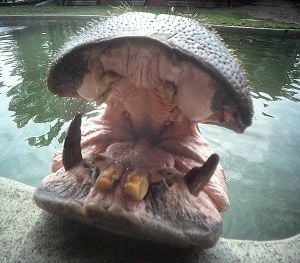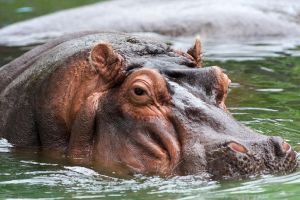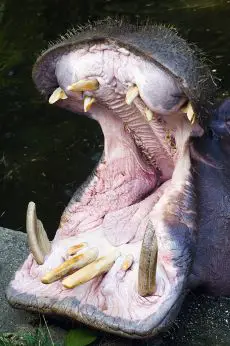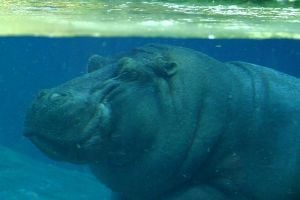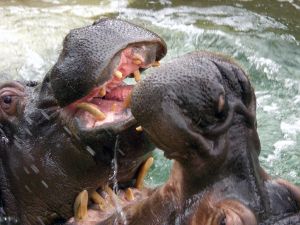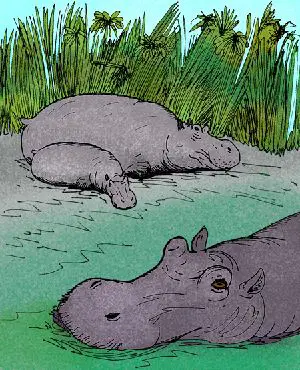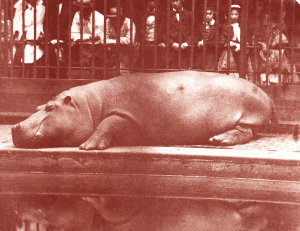Hippopotamus
- "Hippo" redirects here.
- Note: This page is about the species Hippopotamus amphibius.
| Hippopotamus | ||||||||||||||
|---|---|---|---|---|---|---|---|---|---|---|---|---|---|---|
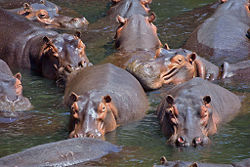 Hippopotamus, Hippopotamus amphibius
| ||||||||||||||
| Scientific classification | ||||||||||||||
| ||||||||||||||
| Hippopotamus amphibius Linnaeus, 1758[2] | ||||||||||||||
![Range map[1]](/d/images/thumb/0/09/Hippo_distribution.gif/230px-Hippo_distribution.gif) Range map[1]
|
Hippopotamus, or hippo, is the common name for a very large, semi-aquatic African mammal, Hippopotamus amphibius, of the Hippopotamidae family of ungulates, characterized by a large, elongated head with an enormous mouth and teeth, a barrel-shaped body, short stumpy legs with four webbed toes, short tail, and nearly hairless thick skin. The term hippopotamus also serves as the common name for any extant or extinct member of the Hippopotamus genus (of which H. amphibius is the only extant member) and sometimes for members of the family Hippopotamidae in general, although the more distinct term "hippopotamids" also is used in this later case. The Hippopotamidae family includes one other extant genus and member, Hexaprotodon liberiensis, the pygmy hippopotamus (sometimes labeled Choeropsis liberiensis). This article will be about Hippopotamus amphibius, which is the third largest land animal (after the elephant and the white rhinoceros) and the heaviest extant artiodactyl.
Although hippopotamuses can be destructive to human agriculture, they add greatly to the mystique and beauty of nature. Whether their reputation as being one of the most aggressive creatures in the world and one of the most dangerous animals in Africa, or the remarkable grace that they exhibit in water, where they can sink to the bottom of rivers and run or walk on the bottom, hippos have long fascinated human beings. Massive in size, with a stocky shape and short legs, these amphibious animals can still easily outrun a human on land, and are very agile in the water as well.
Despite the enrichment they bring to the human fascination with nature, and an important role in both aquatic and terrestrial food chains, hippos have been extirpated from many areas of their range in sub-Saharan Africa, where there are an estimated 125,000 to 150,000 remaining. (The range of the pygmy hippopotamus, Hexaprotodon liberiensis, is limited to West African countries.) Hippos have traditionally been an important food source for native people in Africa, and their teeth (with superior ivory) and hides are also very valuable. They are still threatened by habitat loss and poaching for their meat and ivory canine teeth.
Overview
As even-toed ungulates (order Artiodactyla), hippopotamuses are hoofed mammals with an even number of functional toes (four in hippos) and the main limb axis passing between the middle two digits, in contrast to the odd-toed ungulates (order Perissodactyla), which are characterized by an odd number of functional toes (one or three), with the axis of each limb going through the enlarged middle (third) toe. In addition to hippos, the order Artiodactyla includes such well-known members as pigs, peccaries, camels, deer, giraffes, pronghorns, antelopes, sheep, goats, and cattle. (The related perissodactyls include such well-known members as horses, zebras, tapirs, and rhinoceroses.)
Unlike most even-toed ungulates, the hippopotamuses, pigs, and peccaries are not ruminates. Ruminates are those even-toed ungulates that digest their food by the process of rumination; this means they digest their food in two steps, first by softening it within the animal's first stomach, known as the rumen, then regurgitating the semi-digested mass, now known as cud, and chewing it again. Most, but not all, ruminants have a four-chambered stomach (rumen, reticulum, omasum, and abomasum). Some, like camelids and tragulids, have a three-chambered stomach. The pigs and peccaries have only one small chamber before the abomasum, and hippos (like the camelids and tragulids) have two chambers before the true stomach (in other words, a three-chambered stomach).
The hippopotamus, Hippopotamus amphibius, also known as the common hippopotamus or the Nile hippopotamus, is the type genus of the family Hippopotamidae. The Pygmy Hippopotamus belongs to a different genus in Hippopotamidae, either Choeropsis or Hexaprotodon. Sometimes the sub-family Hippopotaminae is used. Further, some taxonomists group hippopotamuses and anthracotheres in the super-family Anthracotheroidea or Hippopotamoidea.
The hippopotamus (Hippopotamus amphibius) is semi-aquatic, inhabiting rivers and lakes where territorial bulls preside over a stretch of river and groups of 5 to 30 females and young. During the day they remain cool by staying in the water or mud; reproduction and childbirth both occur in water. They emerge at dusk to graze on grass. While hippopotamuses rest near each other in the water, grazing is a solitary activity and hippos are not territorial on land. Agile in the water, the hippo is also fast on land, being clocked at 30 km/h (19 mph) over short distances.
Of the estimated 125,000 to 150,000 hippos throughout Sub-Saharan Africa; Zambia and Tanzania possess the largest populations.[1] Hexaprotodon liberiensis, the pygmy hippopotamus, is limited to West African countries of Liberia, Ivory Coast, Sierra Leone, and Guinea.
The word "hippopotamus" derives from the ancient Greek ἱπποπόταμος, hippopotamos, from ἵππος, hippos, "horse", and ποταμός, potamos, "river", meaning "horse of the river".[3] In English, the plural is hippopotamuses, but hippopotami is also used; hippos can be used as a short plural.
Hippopotamuses are gregarious, living in groups of up to 30 animals; such a group is called a pod, herd, dale or bloat. A male hippopotamus is known as a bull, a female as a cow and a baby as a calf.
Nile crocodiles, lions, and spotted hyenas are known to prey on young hippos.
Subspecies
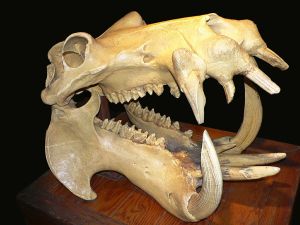
Five subspecies of hippos have been described based on morphological differences in their skulls and geographical differences:[4]
- H. a. amphibius – (the nominate subspecies) which stretched from Egypt, where they are now extinct, south up the Nile River to Tanzania and Mozambique.
- H. a. kiboko – in the Horn of Africa, in Kenya and Somalia. Kiboko is the Swahili word for hippo. Broader nasals and more hollowed interorbital region.
- H. a. capensis – from Zambia to South Africa. Most flattened skull of the subspecies.
- H. a. tschadensis – throughout Western Africa to, as the name suggests, Chad. Slightly shorter and wider face, with prominent orbits.
- H. a. constrictus – in Angola, the southern Democratic Republic of Congo and Namibia. Named for its deeper preorbital constriction.
The suggested subspecies were never widely used or validated by field biologists; the described morphological differences were small enough that they could have resulted from simple variation in non-representative samples.[5] Genetic analyses have tested the existence of three of these putative subspecies. A study examining mitochondrial DNA from skin biopsies taken from 13 sampling locations, considered genetic diversity and structure among hippo populations across the continent. The authors found low but significant genetic differentiation among H. a. amphibius, H. a. capensis, and H. a. kiboko. Neither H.a.tschadensis nor H.a.constrictus have been tested.[6][7]
Description
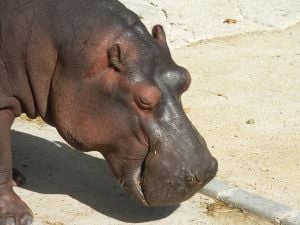
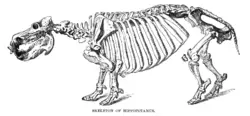
Hippopotamuses are the fourth largest mammals by weight in the world (after whales, elephants, and rhinoceroses). Weighing between 1.5 and 3 metric tons, it is exceeded among land animals only by the three species of elephant (3 to 9 tons) and the white rhinoceros (1.5 to 3.5 tons). Note, however, that the range of hippopotamus' sizes overlaps with the range of the white rhinoceros; use of different metrics makes it unclear which is the largest land animal after elephants. In length, hippos measure 3.3 to 5.2 meters (11 to 17 ft) long, including a tail of about 56 centimeters (22 in) and average about 1.5 meters (5 ft) tall at the shoulder.[8][9]
Because of their enormous size, hippopotamuses are difficult to weigh in the wild. Most estimates of the weight come from culling operations that were carried out in the 1960s. The average weights for adult males ranged between 1,500–1,800 kg (3,300–4,000 lb). Females are smaller than their male counterparts, with average weights measuring between 1,300–1,500 kg (2,900–3,300 lb).[5] Older males can get much larger, reaching at least 3,200 kg (7,100 lb) and occasionally weighing 4,500 kg (9,900 lb).[10][8] Male hippos appear to continue growing throughout their lives; females reach a maximum weight at around age 25.[11]
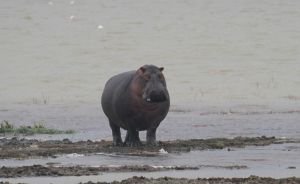
Hippos are considered megafauna, but unlike all other African megafauna, hippos have adapted for a semi-aquatic life in freshwater lakes and rivers.[5]
On the National Geographic Channel television program, "Dangerous Encounters with Brady Barr," Dr. Barr measured the bite force of an adult female hippo at 1,821 lbf (8,100 N); Barr also attempted to measure the bite pressure of an adult male hippo, but had to abandon the attempt due to the male's aggressiveness.[12]
The eyes, ears, and nostrils of hippos are placed high on the roof of the skull. This allows them to be in the water with most of their body submerged in the waters and mud of tropical rivers to stay cool and prevent sunburn. Their skeletal structure is "graviportal,", adapted to carrying the animals' enormous weight. Hippopotamuses have small legs (relative to other megafauna) because the water in which they live reduces the weight burden. Unlike most other semi-aquatic animals, the hippopotamus has very little hair.[5]
Their skin secretes a natural sunscreen substance which is red-colored. The secretion is sometimes referred to as "blood sweat," but is neither blood nor sweat. This secretion is initially colorless and turns red-orange within minutes, eventually becoming brown. Two distinct pigments have been identified in the secretions, one red (hipposudoric acid) and one orange (norhipposudoric acid). Highly acidic compounds, the two pigments both inhibit the growth of disease-causing bacteria; as well, the light absorption of both pigments peaks in the ultraviolet range, creating a sunscreen effect. All hippos, even those with different diets, secrete the pigments, so it does not appear that food is the source of the pigments. Instead, the animals may synthesize the pigments from precursors such as the amino acid tyrosine.[13]
Hippos can live in the water or on land. Their specific gravity allows them to sink and walk or run along the bottom of a river. Even though they are bulky animals, hippopotamuses can run faster than a human on land. Estimates of their running speed vary from 30 km/h (18 mph) to 40 km/h (25 mph), or even 50 km/h (30 mph). The hippo can maintain these higher speeds for only a few hundred meters.[5]
A hippo's lifespan is typically 40 to 50 years.[5]
Distribution
Today, large populations of Hippopotamus amphibius only occur in the Nile River Valley of East Africa.[8] Zambia, with an estimated 40,000 hippos, and Tanzania, with some 20,000–30,000 hippos, contain the largest populations of the estimated 125,000 to 150,000 hippos remaining in Sub-Saharan Africa.[1] Hippos are still found in the rivers and lakes of Uganda, Sudan, Somalia, Kenya, northern Democratic Republic of the Congo, and Ethiopia, west through Ghana to Gambia, and also in Southern Africa (Botswana, Republic of South Africa, Zimbabwe, and Zambia). A separate population exists in Tanzania and Mozambique.
However, Hippopotamus amphibius once was found throughout sub-Saharan Africa, with populations even in Palestine and Madagascar,[14] During the Eemian interglacial period (130,000 years ago to 114,000 years ago) until the late Pleistocene about 30,000 years ago, Hippopotamus amphibius actually was widespread in North Africa and Europe.[15] Pliny the Elder (23 C.E. – 79 C.E.) writes that, in his time, the best location in Egypt for capturing this animal was in the Saite nome;[16] the animal could still be found along the Damietta branch after the Arab Conquest in 639.
Hippos like to dwell in places with permanent water that is not too deep.[5]
Behavior
Hippos spend most of their days wallowing in the water or the mud, with the other members of their pod. The water serves to keep their body temperature down, and to keep their skin from drying out. With the exception of eating, most of hippopotamuses' lives —from childbirth, fighting with other hippos, and reproduction—occur in the water.
Hippos leave the water at dusk and travel inland, sometimes up to 8 kilometers (5 mi), to graze on short grass, their main source of food. They spend four to five hours grazing and can consume 68 kilograms (150 lb) of grass each night.[17] Like almost any herbivore, they will consume many other plants if presented with them, but their diet in nature consists almost entirely of grass, with only minimal consumption of aquatic plants.[18] Hippos have (rarely) been filmed eating carrion, usually close to the water. There are other reports of meat-eating, and even cannibalism and predation.[19] The stomach anatomy of a hippo is not suited to carnivory, and meat-eating is likely caused by aberrant behavior or nutritional stress.[5]
The diet of hippos consists mostly of terrestrial grasses, even though they spend most of their time in the water. Most of their defecation occurs in the water, creating allochthonous deposits of organic matter along the river beds. These deposits have an unclear ecological function.[18] Because of their size and their habit of taking the same paths to feed, hippos can have a significant impact on the land they walk across, both by keeping the land clear of vegetation and depressing the ground. Over prolonged periods, hippos can divert the paths of swamps and channels.[20]
Adult hippos cannot swim and are not buoyant. When in deep water, they usually propel themselves by leaps, pushing off from the bottom. They move at speeds up to 8 km/h (5 mph) in water. Young hippos are buoyant and usually move by swimming, propelling themselves with kicks of their hind legs. Adult hippos typically resurface to breathe every three to five minutes. The young have to breathe every two to three minutes.[5] The process of surfacing and breathing is automatic, and even a hippo sleeping underwater will rise and breathe without waking. A hippo closes its nostrils when it submerges.
Social life
Studying the interaction of male and female hippopotamuses has long been complicated by the fact that hippos are not sexually dimorphic and thus females and young males are almost indistinguishable in the field.[21] Although hippos like to lie close to each other, they do not seem to form social bonds except between mothers and daughters, and are not social animals. The reason they huddle close together is unknown.[5]
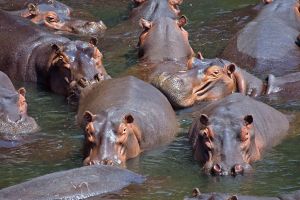
Hippopotamuses are territorial only in water, where a bull presides over a small stretch of river, on average 250 meters in length, and containing ten females. The largest pods can contain up to 100 hippos. Other bachelors are allowed in a bull's stretch, as long as they behave submissively toward the bull. The territories of hippos exist to establish mating rights. Within the pods, the hippos tend to segregate by gender. Bachelors will lounge near other bachelors, females with other females, and the bull on his own. When hippos emerge from the water to graze, they do so individually.[5]
Hippopotamuses appear to communicate verbally, through grunts and bellows, and it is thought that they may practice echolocation, but the purpose of these vocalizations is currently unknown. Hippos have the unique ability to hold their head partially above the water and send out a cry that travels through both water and air; hippos above and under water will respond.[22]
Reproduction
Female hippos reach sexual maturity at five to six years of age and have a gestation period of 8 months. A study of endocrine systems revealed that female hippopotamuses may begin puberty as early as 3 or 4 years of age.[23] Males reach maturity at around 7.5 years.
A study of hippopotamus reproductive behavior in Uganda showed that peak conceptions occurred during the end of the wet season in the summer, and peak births occurred toward the beginning of the wet season in late winter. This is because of the female's estrous cycle; as with most large mammals, male hippopotamus spermatozoa is active year round. Studies of hippos in Zambia and South Africa also showed evidence of births occurring at the start of the wet season.[5] After becoming pregnant, a female hippopotamus will typically not begin ovulation again for 17 months.[23]
Mating occurs in the water with the female submerged for most of the encounter, her head emerging periodically to draw breath. Hippos are one of the few mammals that give birth under water, along with Cetaceans and Sirenians (manatees and dugongs). Baby hippos are born underwater at a weight between 25 and 45 kg (60–110 lb) and an average length of around 127 cm (50 in) and must swim to the surface to take their first breath. A mother typically gives birth to only one hippo, although twins also occur. The young often rest on their mothers' backs when in water that is too deep for them, and they swim underwater to suckle. They also will suckle on land when the mother leaves the water. Weaning starts between six and eight months after birth and most calves are fully weaned after a year.[5]
Like many other large mammals, hippos are described as K-strategists, in this case typically producing just one large, well-developed infant every couple of years (rather than large numbers of small, poorly developed young several times per year, as is common among small mammals such as rodents).[5][23][24]
Aggression
Hippopotamuses are by nature very aggressive animals, especially when young calves are present. Frequent targets of their aggression include crocodiles, which often inhabit the same river habitat as hippos and prey on young hippos.
Hippos are very aggressive towards humans, whom they commonly attack whether in boats or on land with no apparent provocation. They are widely considered to be one of the most dangerous large animals in Africa.
To mark territory, hippos spin their tails while defecating to distribute their excrement over the greatest possible area. Likely for the same reason, hippos are retromingent—that is, they urinate backwards.
Hippos rarely kill each other, even in territorial challenges. Usually a territorial bull and a challenging bachelor will stop fighting when it is clear that one hippo is stronger. When hippos become overpopulated, or when a habitat starts to shrink, bulls will sometimes attempt to kill infants, but this behavior is not common under normal conditions.[24] Some incidents of hippo cannibalism have been documented, but it is believed to be the behavior of distressed or sick hippos, and not healthy behavior.[5]
Origins
Until 1909, naturalists grouped hippos with pigs, based on molar patterns. Several lines of evidence, first from blood proteins, then from molecular systematics[25] and DNA [26][27] and the fossil record, show that their closest living relatives are cetaceans—whales, dolphins and porpoises.[28] The common ancestor of hippos and whales branched off from Ruminantia and the rest of the even-toed ungulates; the cetacean and hippo lineages split soon afterward.[26][29]
A recent theory of the origins of Hippopotamidae suggests that hippos and whales shared a common semi-aquatic ancestor that branched off from other artiodactyls around 60 million years ago (mya).[26][28] This hypothesized ancestral group likely split into two branches around 54 mya.[25] One branch would evolve into cetaceans, possibly beginning about 52 mya, with the proto-whale Pakicetus and other early whale ancestors collectively known as Archaeoceti, which eventually underwent aquatic adaptation into the completely aquatic cetaceans.[29]
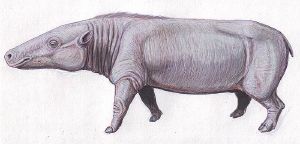
The other branch became the anthracotheres, a large family of four-legged beasts, the earliest of whom in the late Eocene would have resembled skinny hippopotamuses with comparatively small and narrow heads. All branches of the anthracotheres, except that which evolved into Hippopotamidae, became extinct during the Pliocene without leaving any descendants.[28]
A rough evolutionary lineage can be traced from Eocene and Oligocene species (Anthracotherium and Elomeryx) to the Miocene (Merycopotamus and Libycosaurus) and the very latest anthracotheres in the Pliocene.[30] Merycopotamus, Libycosaurus and all hippopotamids can be considered to form a clade, with Libycosaurus being more closely related to hippos. Their common ancestor would have lived in the Miocene, about 20 mya.
Hippopotamids therefore are deeply nested within the family Anthracotheriidae. The Hippopotamidae are believed to have evolved in Africa; the oldest known hippopotamid is the genus Kenyapotamus which lived in Africa from 16 to 18 mya. While hippopotamid species spread across Asia and Europe, no hippopotamuses have ever been discovered in the Americas, although various anthracothere genera emigrated into North America during the early Oligocene. From 7.5 to 1.8 mya, an ancestor to the modern hippopotamus, Archaeopotamus, lived in Africa and the Middle East.[31]
While the fossil record of hippos is still poorly understood, the two modern genera, Hippopotamus and Choeropsis (sometimes Hexaprotodon), may have diverged as far back as 8 mya. Taxonomists disagree whether or not the modern pygmy hippopotamus is a member of Hexaprotodon—an apparently paraphyletic genus also embracing many extinct Asian hippopotamuses that is more closely related to Hippopotamus—or Choeropsis—an older and basal genus.[30][31]
Recent extinct species
As many as three species of Malagasy hippopotamus became extinct during the Holocene on Madagascar, one of them within the past 1,000 years. The Malagasy hippos were smaller than the modern hippopotamus, likely through the process of insular dwarfism.[32] There is fossil evidence that many Malagasy hippos were hunted by humans, a likely factor in their eventual extinction.[32][33] Isolated members of Malagasy hippopotamus may have survived in remote pockets; in 1976, villagers described a living animal called the Kilopilopitsofy, which may have been a Malagasy Hippopotamus.[34]
Two separate species of hippopotamus, the European hippopotamus (H. antiquus) and H. gorgops, ranged throughout continental Europe and the British Isles. Both species became extinct before the last glaciation. Ancestors of European hippos found their way to many islands of the Mediterranean during the Pleistocene.[35] Both species were larger than the modern hippopotamus, averaging about 1 meter (3.3 feet) longer.
The Pleistocene also saw a number of dwarf species evolve on several Mediterranean islands including Crete (H. creutzburgi), Cyprus (H. minor), Malta (H. melitensis) and Sicily (H. pentlandi). Of these, the Cyprus dwarf hippopotamus survived until the end of the Pleistocene or early Holocene. Evidence from an archaeological site Aetokremnos continues to cause debate on whether or not the species was encountered, and was driven to extinction, by humans.[36][35]
Conservation status
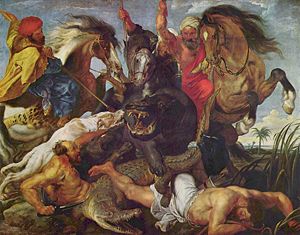
In May 2006 the hippopotamus was identified as a vulnerable species on the IUCN Red List drawn up by the World Conservation Union (IUCN), with an estimated population of between 125,000 and 150,000 hippos, a decline of between 7 percent and 20 percent since the IUCN's 1996 study.[1]
The decline in hippos has been linked to Hunregulated hunting and poaching. Habitat loss is also a factor. Genetic evidence suggests that common hippos in Africa experienced a marked population expansion during or after the Pleistocene Epoch that is attributed to an increase in water bodies at the end of the era. These findings have important conservation implications as hippo populations across the continent are currently threatened by loss of access to fresh water.[6]
The hippo population declined most dramatically in the Democratic Republic of the Congo.[37] The population in Virunga National Park had dropped to 800 or 900 from around 29,000 in the mid 1970s.[38] The decline is attributed to the disruptions caused by the Second Congo War.[38] The poachers are believed to be former Hutu rebels, poorly paid Congolese soldiers, and local militia groups.[38] Reasons for poaching include the belief that hippos are harmful to society, and also for money. The sale of hippo meat is illegal, but black-market sales are difficult for Virunga National Park officers to track.[38]
Hippos and humans
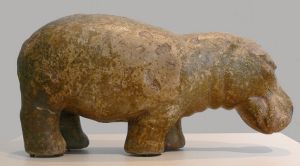
The earliest evidence of human interaction with hippos comes from butchery cut marks upon hippo bones at Bouri Formation dated around 160,000 years ago.[39] Later rock paintings and engravings showing hippos being hunted have been found in the mountains of the central Sahara dated 4,000–5,000 years ago near Djanet in the Tassili n'Ajjer Mountains. Hippos were also well-known to the ancient Egyptians, where the hippo was recognized as a ferocious denizen of the Nile.[5] In Ancient Egyptian Religion, the hippopotamus-headed Tawaret was a goddess of protection in pregnancy and childbirth, because ancient Egyptians recognized the protective nature of a female hippopotamus toward her young.[40]
The hippopotamus has been known to historians since classical antiquity. The Greek historian Herodotus described the hippopotamus in The Histories (written circa 440 B.C.E.) and the Roman Historian Pliny the Elder wrote about the hippopotamus in his encyclopedia Naturalis Historia (written circa 77 C.E.).
Hippos in zoos
Hippopotamuses have long been popular zoo animals. The first zoo hippo in modern history was Obaysch who arrived at the London Zoo on May 25, 1850, where he attracted up to 10,000 visitors a day and inspired a popular song, the Hippopotamus Polka.[41] Hippos have remained popular zoo animals since Obaysch, and generally breed well in captivity. Their birth rates are lower than in the wild, but this is attributed to zoos' not wanting to breed as many hippos as possible, since hippos are large and relatively expensive animals to maintain.[5][41]
Most hippos in zoos today were born in captivity. There are enough hippos in the international zoo system that introducing further animals from the wild will be unnecessary if zoos cooperate to maintain the genetic diversity of the breeding stock.[5]
Like many zoo animals, hippos were traditionally displayed in concrete exhibits. In the case of hippos, they usually had a pool of water and patch of grass. In the 1980s, zoo designers increasingly designed exhibits that reflected the animals' native habitats. One of the more well known exhibits, the Toledo Zoo Hippoquarium, features a 360,000 gallon pool for hippos.[42] In 1987, researchers were able to tape, for the first time, an underwater birth (as in the wild) at the Toledo Zoo. The exhibit was so popular that the hippos became the logo of the Toledo Zoo.
Cultural depictions
The hippopotamus was known to the Greeks and Romans as the Beast of the Nile. A red hippo also represented the Ancient Egyptian god Set; the thigh is the "phallic leg of Set," symbolic of virility. Set's consort Tawaret was also seen as part hippo.[43] The Behemoth from the Book of Job, 40:15–24 is also thought by some to be based on a hippo.[44]
Ever since Obaysch inspired the Hippopotamus Polka, hippos have been popular animals in Western culture for their rotund appearance that many consider comical.[41] Fictional stories with hippo characters—like Huberta who was depicted as trekking across South Africa,[45] or the tale of Owen and Mzee, a hippo and tortoise who developed an intimate bond[46]—have amused people who have bought hippo books, merchandise, and many a stuffed hippo toy. Hippos have been featured in songs like "I Want a Hippopotamus for Christmas" (which became a hit for child star Gayla Peevey in 1953), "The Hippopotamus" and "Hippo Encore." Hippos have also been popular cartoon characters, where their rotund frame is used for humorous effect. The Disney film Fantasia featured a ballerina hippopotamus dancing to the opera, La Gioconda.[37]
The hippopotamus was one of the many exotic animals brought to fight gladiators in Rome by the emperor Philip I the Arab to commemorate Rome's 1000 years anniversary in 248 C.E. Silver coins with a hippo's image were minted that year.
ReferencesISBN links support NWE through referral fees
- ↑ 1.0 1.1 1.2 1.3 1.4 R. Lewison, and W. Oliver (IUCN SSC Hippo Specialist Subgroup), Hippopotamus amphibius IUCN 2010. IUCN Red List of Threatened Species. Retrieved January 29, 2011. Database entry includes a range map and justification for why this species is vulnerable.
- ↑ Integrated Taxonomic Information System, Hippopotamus amphibius ITIS Taxonomic Serial No.: 625024 (2011). Retrieved January 29, 2011.
- ↑ Merriam-Webster, "Hippopotamus," Merriam-Webster's Online Dictionary. Retrieved January 29, 2011.
- ↑ R. Lydekker, Catalogue of the Ungulate Mammals in the British Museum of Natural History, volume 5 (London: British Museum, 1915).
- ↑ 5.00 5.01 5.02 5.03 5.04 5.05 5.06 5.07 5.08 5.09 5.10 5.11 5.12 5.13 5.14 5.15 5.16 5.17 S. K. Eltringham, The Hippos (London: Academic Press, 1999). ISBN 085661131X.
- ↑ 6.0 6.1 J. B. A. Okello, S. Nyakaana, C. Masembe, H. R. Siegismund, and P. Arctander, "Mitochondrial DNA variation of the common hippopotamus: Evidence for a recent population expansion," Heredity 95(2005), issue 3: 206-215. PMID 16030528.
- ↑ IUCN/SSC Pigs, Peccaries, and Hippos Specialist Group (PPHSG), "Suiform Soundings," IUCN/SSC Pigs, Peccaries, and Hippos Specialist Group (PPHSG) Newsletter5(2005), issue 1.
- ↑ 8.0 8.1 8.2 N. Shefferly, "Hippopotamus amphibius," Animal Diversity Web (2001). Retrieved January 29, 2011.
- ↑ San Diego Zoo, "Mammals: Hippopotamus," Zoological Society of San Diego (2011).Retrieved January 29, 2011.
- ↑ S. Herrick, "Hippopotamus," WhoZoo (2010). Retrieved January 29, 2011.
- ↑ P. J. Marshall, and J. A. Sayer, "Population ecology and response to cropping of a hippopotamus population in eastern Zambia," Journal of Applied Ecology 13(1976), iss. 2: 391–403.
- ↑ B. Barr, "Undercover Hippo," Dangerous Encounters (National Geographic Channel, January 20, 2008).
- ↑ Y. Saikawa, K. Hashimoto, M. Nakata, M. Yoshihara, K. Nagai, M. Ida, and T. Komiya, "Pigment chemistry: The red sweat of the hippopotamus," Nature 429(2004), iss. 6990: 363. PMID 15164051.
- ↑ D. Fox, and P. Myers, "Family Hippopotamidae," Animal Diversity Web (2000). Retrieved January 29, 2011.].
- ↑ T. van Kolfschoten, "The Eemian mammal fauna of central Europe," Netherlands Journal of Geosciences 79(2000), iss. 2/3: 269–281. Retrieved January 29, 2011.
- ↑ Pliny the Elder, Naturalis Historia], Chapter 15, Book VIII. (The Eigth Booke of the Historie of Natvre, English Translation). Retrieved January 29, 2011.
- ↑ Kruger National Park, "Hippopotamus," Kruger National Park (no date). Retrieved January 30, 2011.
- ↑ 18.0 18.1 J. Grey, and D. M. Harper, "Using stable isotope analyses to identify allochthonous inputs to Lake Naivasha mediated via the hippopotamus gut," Isotopes in Environmental Health Studies 38(2002), issue 4: 245–250. Retrieved January 30, 2011.
- ↑ J. P. Dudley, "Reports of carnivory by the common hippo Hippopotamus Amphibius," South African Journal of Wildlife Research 28(1998), issue 2: 58–59. Retrieved January 30, 2011.
- ↑ T. S. McCarthy, W. N. Ellery, and A. Bloem, "Some observations on the geomorphological impact of hippopotamus (Hippopotamus amphibius L.) in the Okavango Delta, Botswana," African Journal of Ecology 36(1998), issue 1: 44–56.
- ↑ R. Beckwitt, J. Shea, D. Osborne, S. Krueger, and W. Barklow, "A PCR-based method for sex identification in Hippopotamus amphibius, African Zoology Journal 37(2002): 127–130. Retrieved January 30, 2011.
- ↑ W. E. Barklow, "Low-frequency sounds and amphibious communication in Hippopotamus amphibious," The Journal of the Acoustical Society of America 115(2004): 2555. Retrieved January 30, 2011.
- ↑ 23.0 23.1 23.2 L. H. Graham, K. Reid, T. Webster, M. Richards,and S. Joseph, "Endocrine patterns associated with reproduction in the Nile hippopotamus (Hippopotamus amphibius) as assessed by fecal progestagen analysis," General and Comparative Endocrinology 128(2002), iss. 1: 74–81. PMID 12270790.
- ↑ 24.0 24.1 R. Lewison, "Infanticide in the hippopotamus: Evidence for polygynous ungulates," Ethology, Ecology & Evolution 10(1998), iss. 3: 277–286.
- ↑ 25.0 25.1 B. M. Ursing, and U. Arnason, "Analyses of mitochondrial genomes strongly support a hippopotamus-whale clade," Proceedings of the Royal Society 265(1998), iss. 1412: 2251. PMID 9881471. Retrieved January 30, 2011.
- ↑ 26.0 26.1 26.2 J. Gatesy, "More DNA support for a Cetacea/Hippopotamidae clade: The blood-clotting protein gene gamma-fibrinogen," Molecular Biology and Evolution 14(1997): 537–543. PMID 9159931. Retrieved January 30, 2011.
- ↑ J. H. Geisler, and J. M. Theodor, "Hippopotamus and whale phylogeny," Nature 458(2009), iss. 7236:E1. PMID 19295550. Retrieved January 30, 2011.
- ↑ 28.0 28.1 28.2 R. Sanders, "Scientists find missing link between the dolphin, whale and its closest relative, the hippo," InnovationsReport.com (2005). Retrieved January 30, 2011.
- ↑ 29.0 29.1 J.-R. Boisserie, F. Lihoreau, and M. Brunet, "The position of Hippopotamidae within Cetartiodactyla," Proceedings of the National Academy of Sciences 102(2005), iss. 5: 1537–1541. PMID 15677331.
- ↑ 30.0 30.1 J.-R. Boisserie, F. Lihoreau, and M. Brunet, "Origins of Hippopotamidae (Mammalia, Cetartiodactyla): Towards resolution," Zoologica Scripta 34(2005), iss. 2: 119–143. Retrieved January 30, 2011.
- ↑ 31.0 31.1 J.-R. Boisserie, [http://www3.interscience.wiley.com/journal/119919310/abstract "The phylogeny and taxonomy of Hippopotamidae (Mammalia: Artiodactyla): A review based on morphology and cladistic analysis," Zoological Journal of the Linnean Society 143: 1–26. Retrieved January 30, 2011.
- ↑ 32.0 32.1 S. Stuenes, "Taxonomy, habits and relationships of the sub-fossil Madagascan hippopotamuses Hippopotamus lemerlei and H. madagascariensis," Journal of Vertebrate Paleontology 9(1989): 241–268.
- ↑ P. Tyson, The Eighth Continent; Life, Death and Discovery in the Lost World of Madagascar. (New York: William Morrow, 2000). ISBN 0380975777.
- ↑ D. A. Burney, and Ramilisonina, "The kilopilopitsofy, kidoky, and bokyboky: Accounts of strange animals from Belo-sur-mer, Madagascar, and the megafaunal "extinction window," American Anthropologist 100(1998): 957–966.
- ↑ 35.0 35.1 C. Petronio, "Note on the taxonomy of Pleistocene hippopotamuses," Ibex 3(1995): 53–55.
- ↑ A. Simmons, "Faunal extinction in an island society: Pygmy hippopotamus hunters of Cyprus," Geoarchaeology 15(2000), iss. 4: 379–381.
- ↑ 37.0 37.1 P. Raffaele, "Hippo haven," Smithsonian Magazine January 2006. Retrieved January 30, 2011.
- ↑ 38.0 38.1 38.2 38.3 BBC, "DR Congo's hippos face extinction," BBC September 13, 2005. Retrieved January 30, 2011.
- ↑ J. D. Clark, Y. Beyene, G. WoldeGabriel, et. al., "Stratigraphic, chronological and behavioural contexts of Pleistocene Homo sapiens from Middle Awash, Ethiopia," Nature 423(2003), iss. 6941: 747–52. PMID 12802333.
- ↑ G. Hart, A Dictionary of Egyptian Gods and Goddesses (Routledge, 1986). ISBN 0415059097.
- ↑ 41.0 41.1 41.2 N. J. Root, "Victorian England’s Hippomania," Natural History 103(1993): 34–39}}
- ↑ M. Greene, "No rms, jungle vu: A new group of 'landscape-immersion' zoo designers are trying to break down visitors' sense of security by reminding them that wild animals really are wild," Atlantic Monthly December 1987.
- ↑ J. C. Cooper, Symbolic and Mythological Animals (London: Aquarian Press, 1992). ISBN 1855381184}}
- ↑ B. M. Metzeger, and M. D. Coogan, eds., The Oxford Companion to the Bible. (Oxford, UK: Oxford University Press, 1993). ISBN 0195046455.
- ↑ H. A. Chilvers, Huberta Goes South, a Record of the Lone Trek of the Celebrated Zululand Hippopotamus (London: Gordon & Gotch, 1931)
- ↑ I. Hatkoff, C. Hatkoff, and P. Kahumbu, Owen & Mzee; The True Story of a Remarkable Friendship (New York: Scholastic Press, 2006)
Credits
New World Encyclopedia writers and editors rewrote and completed the Wikipedia article in accordance with New World Encyclopedia standards. This article abides by terms of the Creative Commons CC-by-sa 3.0 License (CC-by-sa), which may be used and disseminated with proper attribution. Credit is due under the terms of this license that can reference both the New World Encyclopedia contributors and the selfless volunteer contributors of the Wikimedia Foundation. To cite this article click here for a list of acceptable citing formats.The history of earlier contributions by wikipedians is accessible to researchers here:
The history of this article since it was imported to New World Encyclopedia:
Note: Some restrictions may apply to use of individual images which are separately licensed.

